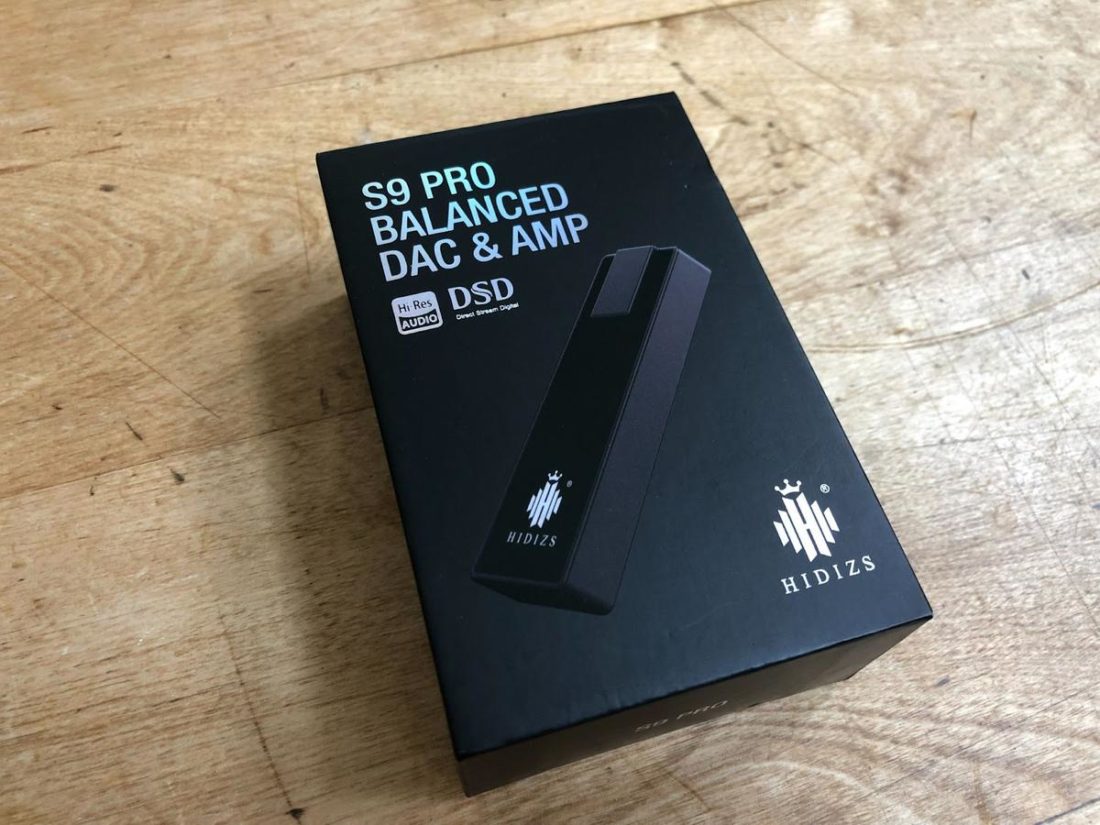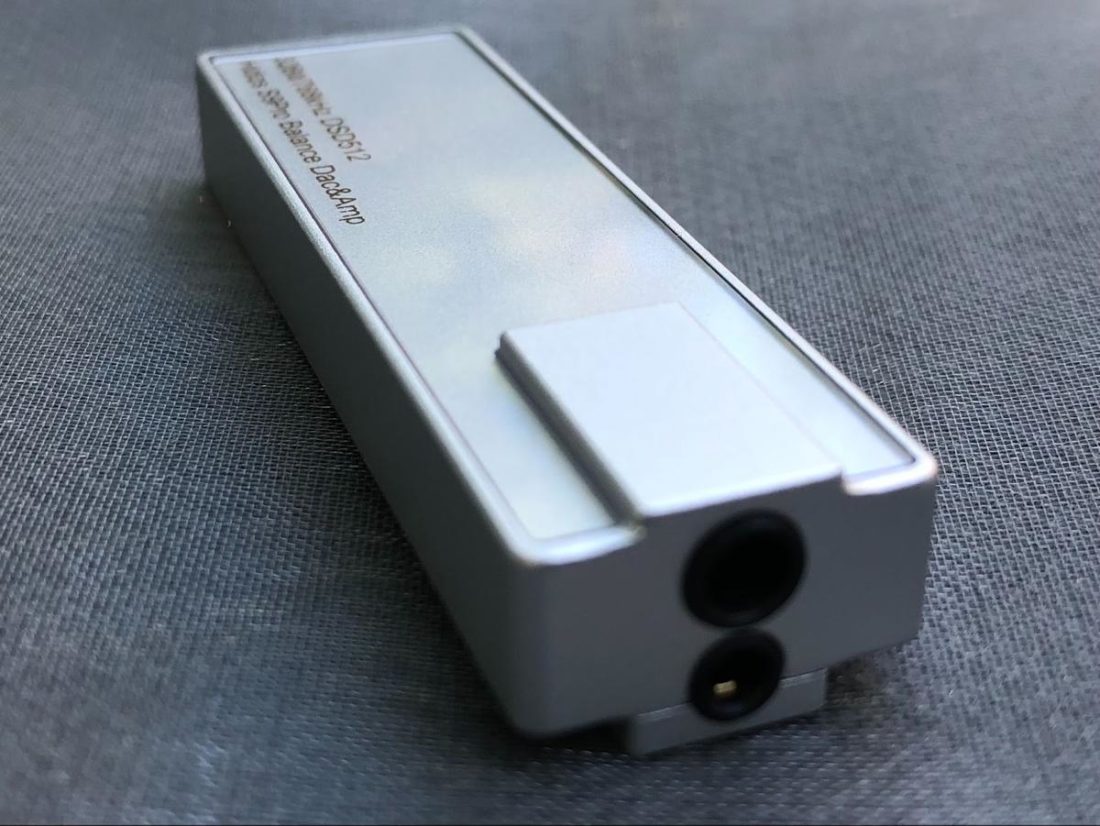The S9 PRO has a crisp sound and lots of juice but you pay for it with a high battery drain.
My personal mini-donglemania continues with a review of the Hidizs S9 PRO balanced DAC/amp. I recently reviewed the Audirect Atom 2, which, unlike the S9 PRO, is a small DAC/amp meant to plug directly into the bottom of a phone (or tablet) without an OTG cable. The S9 PRO is about twice as long and connects to the source device via a short removable USB-c cable.
- Clean and detailed sound
- Lots of amplifier power for a dongle and is sufficient to drive less sensitive or less efficient headphones
- Includes both single-ended and balanced outputs
- High source battery usage
- No included lightning to USB-c cable requires additional purchases for Apple users
- Sound signature leans towards a colder and sterile presentation
Since I’m an iPhone guy, I SHOULD be able to just use a USB-c to lightning OTG cable to connect the S9 PRO. And if you are also an iPhone-type person, you’ll know that this simple solution seldom (if ever) works. Even my recent purchase of the high-quality xDuoo X-C15 cable, which works fine with xDuoo devices, won’t work with the S9 PRO. Ugh.
Luckily the ddHiFi TC28i lightning to USB-c adapter rarely lets me down, and this time was no exception. With a minimum of added bulkiness, the S9 PRO works fine with my Apple phone connected via the included USB-c to USB-c OTG cable to the TC28i.

The S9 PRO is an upgraded version of their well-regarded S9 model, including a new DAC chipset (ESS ES9038Q2M) and more output power, housed in the same physical format. Last year’s loss of the AKM semiconductor manufacturing plant due to fire likely explains the S9 revision and move to the ESS chip.
The S9 PRO is in the USD $100-$150 range of DAC/amp dongles, moving it out of the lowest price tier. At least on paper, the higher output power and balanced output seem to make the jump in price worthwhile compared to lesser models.
The proof (as they say) is in the pudding. Tuck in your napkin, grab a spoon, and dig in.
Company Overview
Hidizs (pronounced ‘hid-is’) was founded in 2009 in Guangdong Province, China, by a group of technicians with HiFi audio research and development experience. Their goal was “to produce a superior and affordable pocket HiFi audio device.”
In 2010 they started researching the global HiFi audio market, and they officially finalized their team in 2012. The AP100, launched in 2014, was the first music player created by Hidizs. In 2017, they funded the AP200 DAP through Kickstarter. 2018 saw the release of the AP80 DAP, and in 2019 the Hidizs team branched out and produced the Mermaid MS4 IEMs.
Now the Hidizs company offers several different DAPs, IEMs, Bluetooth modules, DACs, amplifiers, and accessories.
Technical Specifications
- Form: Portable DAC/amp
- Connection: USB Type-C
- Format Support: Up to 32Bit/768kHz PCM, Native DSD512
- Output Power: 100mW@32Ω SE, 200mW@32Ω Balanced
- Frequency Response: 20Hz-50kHz
- SNR: 120dB SE, 119 Balanced
- Channel Separation: 80dB SE, 118dB Balanced @32 Ohms
- THD+N: 0.0012% SE, 0.0006% Balanced @32 Ohms

Packaging
Hidizs knows how to make attractive and functional packaging. The product photo and name are clearly stamped on the front of the black cardboard box, while the back cover lists the specifications in very, VERY tiny silver letters. Hush you, I clearly don’t need reading glasses. Ahem.
Lift off the lid and the S9 PRO is nestled in paper-lined black foam, with a handy little ribbon to lift it out. Underneath, a small paper door grants access to the included accessories.

In the box
- Hidizs S9 PRO
- Silver Type-C to Type-C cable (145mm)
- Type-C to USB-A adapter
- Translucent plastic clip
- User manual
- Serial number card
- Quality control certificate
- Hidizs 10% off e-gift card
- 2 Hi-Res Audio logo stickers
It’s not exactly an exciting bunch of accessories, but it is kind of fun to stick Hi-Res audio logos to absolutely not certified devices. Passive analog switch box? Now it’s a Hi-Res passive switch box! Coincidentally my turntable now plays Hi-Res vinyl. It’s like magic I tell you.

As noted, there is no lightning to USB-c OTG cable included (good luck to you finding one that works). Also, I’m not sure how useful the clip-on plastic case is, as the S9 PRO has to be within 10cm or so of your phone if you use the included cable, which severely limits your clipping options.
Design
The S9 PRO is a small (approximately 60x18x8mm) aluminum rectangle with one glassy surface that lists its name (spelled incorrectly? Ack) and decoding capabilities. The other side has the Hidizs logo which changes color to show the file format currently playing. One of the short ends has both the 2.5 + 3.5mm outputs (and a bump to accommodate them) and the other has the USB-c socket. The headphone outputs are located too closely together to allow for simultaneous usage.

Simple. But it works.
The S9 PRO is available both in basic black and brushed silver finishes. It rather resembles (and weighs about the same as) an old-fashioned pack of stick gum, if that gum pack was CNC milled from solid aluminum.
No physical buttons mean the source device controls all playback and volume adjustments. The number of fine volume adjustments is limited by your source device, which may result in a narrow usable range with very sensitive IEMs. Things can ramp up to ‘too loud’ very quickly.
Battery life
DAC/amp dongles do not have internal batteries, and this is one of their biggest defining elements. To function, they must siphon power from the source device that they are plugged into. For higher output power there is a compromise that must be made in the form of increased battery draw. The more power output, the more battery drain.

The S9 PRO is a powerful dongle, and it has the voracious battery appetite to prove it. My not-young iPhone X struggles with battery life at the best of times and using the S9 PRO clearly uses up the battery reserves at a much quicker rate (about 30+% faster by my best reckoning).
The good folks over at audioreviews.org have posted their measurements of battery drain for various dongles. As a point of reference, they measure the basic Apple 3.5mm dongle drain as 159 mAh after 3 hours (the best performer on the list). Audioquest Dragonflies rate between 350-480 mAh.
The worst offender on their list is the S9 PRO at 854 mAh (more than 5 times higher consumption than the Apple dongle!). This measurement was performed in single-ended mode and balanced mode is not listed, although it is safe to assume the balanced connection consumes even more battery due to its higher output power.

LED active bitrate indicator
| Color | Bitrate/Meaning |
|---|---|
| Green | PCM 44.1/48/88.2/96 kHz |
| Blue | PCM 176.4/192 kHz |
| Red | PCM 352.8/384 kHz |
| White | PCM 705.6/768 kHz |
| Yellow | DSD 64/128 |
| Purple | DSD 256/512 |
Internals
The S9 PRO uses the flagship Sabre ESS9038Q2M mobile chipset. To put this in perspective, Burson Audio employs a pair of these chips in their TOTL Conductor Reference desktop components. This chipset is absolutely capable of class-leading performance.

This explains the S9 PRO compatibility with the highest bitrate files (32/768 PCM and DSD 512), high channel separation (80dB SE, 118dB balanced @32 Ohms), and low distortion (0.0012% SE, 0.0006% balanced @32 Ohms) numbers.
As discussed, power is abundant for a dongle (100mW@32Ω SE, 200mW@32Ω balanced). This is around 2 volts SE, and 4 volts balanced, which is sufficient to drive most moderately difficult headphones and IEMs. Compare this to the 62mW@32Ω of the recently reviewed Audirect Atom 2 dongle.

Hidizs S9 PRO Sound
Since the Audirect Atom 2 and the S9 PRO are both sitting on my desk, much of my listening was done as a direct comparison between the two. I primarily conducted my evaluation with the new gold colorway 1MORE Triple Driver over-ear headphones.
The Triple Driver headphones are priced in a similar range as the dongles and have a rated impedance of 32 Ohms and sensitivity of 104 dB. Their rated maximum power is 50mW, which is an optimal match for the Atom 2’s 62mW@32Ω power output rating.

The audible differences between the two dongles are easily discernible. Where the Atom 2 has a warmer, mid-bass boosted, overall smoother sound, the S9 PRO is crisper. The Atom 2 comes across as having a bigger low-end, while the S9 sounds faster and more defined. Individual notes and percussion are more discreetly distinguishable, and details jump out of the music.
The S9 PRO approach is more analytical and lean. It’s very clean and fast; there is no discernable noise floor, nor hiss with efficient IEMs. The sound signature appears identical between the two outputs, with just a power jump when using the 2.5mm balanced jack. Power is actually sufficient to drive the 300 Ohm Sennheiser HD650 full-sized headphones to loud volume levels with acceptable fidelity.
As with much of audio, whether you appreciate the S9 PRO presentation is a matter of taste. It’s a bit more flat, linear, and crisper than is my typical preference. That’s not to say there are any major flaws or issues. It provides clean sound, just with less of those warm harmonics that provoke emotion and tickle my eardrums so pleasantly.
Where to Buy
Conclusion
To me, a dongle is primarily for use on the go, so I value ease of use, portability, and low battery drain over output power. I’m going to pair a dongle with easy-to-drive IEMs for mobile usage. I have plenty of desktop amplifier power at home to drive inefficient full-sized cans.
The battery drain compromise presented by the S9 PRO doesn’t really match my preferences.

That being said, I can absolutely see why the S9 PRO is a contender on many a best-of list. If your audio tastes lean towards the highest detail reproduction, or you want to be able to use your phone with a wide variety of headphones and IEMs, the S9 PRO offers a simple and affordable solution.
For less than $150, the S9 PRO provides a compelling mixture of power and fidelity, rivaling the sound quality of far more expensive devices. The addition of a balanced circuit is icing on the cake, but all that sugar comes with a cost.
The S9 PRO is a hungry little beast, and to it, your phone’s battery looks very sweet and delicious.

So get a wireless phone charger and enjoy the sound a little longer! 🙂
Can the Hidizs S9 Pro drive the Hifiman Arya Stealth?
I’m sorry, I don’t have the Stealth on hand to physically try, but you can get an idea of power requirements using our calculator.
S9Pro gets very hot and drains IPad current quickly, more so than Red Dragonfly which I owned. Its boxy shape makes it much less agreeable to hold than Dragonfly’s rounded edges. Hidizs cable (Lightning to USB-C) purchased at the same time to connect with IPad was found defective after 4 months of normal use, within warranty period. Three months after we have agreed to compensate with a replacement adaptor, nothing was received and, furthermore, hello@hidizs failed to answer my last request. I will not buy from this company again and cannot recommend it.